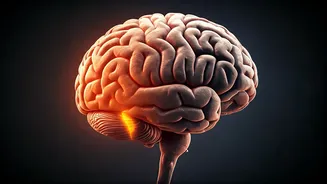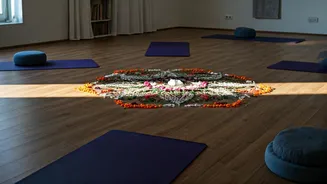The Power of Yoga
Yoga, a practice rooted in ancient traditions, offers an extraordinary pathway to sharpen both memory and concentration. Integrating specific yoga poses
into your daily routine is a remarkable method for enhancing brain function. The poses highlighted in this piece, each needing a mere 10 minutes, have been practiced for centuries. These ancient techniques have been carefully designed and refined over generations. Their effectiveness lies in their ability to improve blood flow, reduce stress, and promote mental clarity. By regularly performing these yoga poses, you can cultivate a sharper mind and improve your cognitive capabilities. The practice not only enhances mental performance but also contributes to overall well-being, fostering a balanced and focused state of mind.
Vrikshasana: The Tree Pose
Vrikshasana, or the tree pose, is a fundamental posture in yoga, renowned for its grounding effects and its ability to sharpen focus. To perform Vrikshasana, begin by standing tall with your feet firmly planted on the ground. Slowly lift one foot and place it either on your inner thigh or calf of the standing leg, avoiding the knee. Once your balance is secure, bring your hands together in a prayer position at your chest. Deeply breathe and maintain your gaze on a fixed point to aid balance. This pose enhances concentration by stabilizing the body and mind. Regular practice improves your balance, posture, and coordination, all while enhancing your mental focus. The unwavering attention needed to maintain this posture translates into improved cognitive function and enhanced clarity of thought, making Vrikshasana a valuable addition to your memory-boosting routine.
Ardha Matsyendrasana: Spinal Twist
Ardha Matsyendrasana, or the seated spinal twist, offers a dynamic method to invigorate the mind. This pose stimulates the spine and improves circulation, which can positively affect brain function and memory. Sit on the floor with your legs extended. Bend your right knee, placing your foot outside your left thigh. Place your left hand on the floor behind you for support and place your right hand on your left knee. With each inhalation, elongate your spine, and with each exhalation, gently twist your torso to the left, looking over your left shoulder. Hold the pose, breathing deeply. This twisting action improves blood flow, allowing oxygen to reach the brain more efficiently. The twist removes any mental stagnation, allowing for enhanced focus and a heightened state of mental alertness. Consistent practice of Ardha Matsyendrasana can foster improved cognitive function and increased mental agility.
Supta Baddha Konasana
Supta Baddha Konasana, or reclined bound angle pose, is a soothing and effective way to promote relaxation and enhance focus. The gentle opening of the hips and inner thighs encourages deeper breathing, which is crucial for brain health. To perform this pose, lie on your back with the soles of your feet together, allowing your knees to fall open to the sides. Use support, like pillows or blankets, under your knees if needed to maintain comfort. Close your eyes and focus on your breath. Breathe deeply and allow your body to fully relax. This pose facilitates a calming effect on the nervous system, reducing stress and anxiety, which can hinder memory and concentration. By calming the mind, Supta Baddha Konasana clears the way for enhanced focus and improved cognitive performance. The deep relaxation helps the brain to reset, promoting mental clarity and improved recall.
Padahastasana: Standing Forward Bend
Padahastasana, or standing forward bend, promotes increased blood flow to the head, boosting cognitive function. To assume this posture, stand with your feet hip-width apart and gently bend forward from your hips. Keep your knees slightly bent to prevent strain and let your hands rest on the floor or grasp your ankles. Allow your head to hang heavy, relaxing your neck. Breathe deeply and feel the stretch in your hamstrings and spine. This inverted posture increases blood circulation to the brain, providing it with more oxygen and nutrients. This enriched supply can improve memory and enhance focus. Consistent practice boosts energy levels and promotes mental clarity. Padahastasana invigorates the mind and improves its ability to process information. This straightforward pose makes a valuable addition to any daily routine, improving cognitive performance.
Bhramari Pranayama: Humming Breath
Bhramari Pranayama, the humming bee breath, is a powerful breathing exercise that swiftly calms the mind and enhances mental clarity. To practice this, sit comfortably with your spine straight and your eyes closed. Place your index fingers gently into your ears to block external sounds. Inhale deeply through your nose, and as you exhale, create a humming sound like a bee. Feel the vibrations throughout your head and face. The humming sound and focused breathing assist in calming the nervous system and reducing mental chatter. This exercise is incredibly beneficial for relieving stress and anxiety, which frequently impede memory and focus. The regular practice of Bhramari Pranayama can drastically improve concentration and sharpen memory. The calming effect on the mind, paired with increased awareness, equips you with tools to handle stress and enhance cognitive performance.
Matsyasana: The Fish Pose
Matsyasana, or the fish pose, is excellent for stimulating the thyroid and pituitary glands, which are significant for memory and concentration. Begin by lying on your back with your legs extended. Place your hands, palms down, underneath your hips. Lift your chest and rest your head on the floor, or slightly arching your back and resting your head. Keep your legs active and engaged. The gentle backbend stretches the neck and stimulates the thyroid. The fish pose encourages deeper breathing, which delivers more oxygen to the brain. This can result in improved mental clarity and focus. Performing Matsyasana regularly can enhance your cognitive performance and support a healthy mind. It assists in releasing tension and promoting a sense of calm. With regular practice, the mind will gain clarity and focus.












